When it comes to self-management and living your best life with Chronic Obstructive Pulmonary Disease (COPD), an action plan can be an invaluable resource.
As we head towards the cooler months of the year and flu season, there will be more viruses and bugs in the community; and it will be more common for someone living with COPD to experience an exacerbation or flare-up of their symptoms.
If you have a written COPD action plan, ask your doctor to update it. But if you have never had a written COPD Action Plan, now is the time to talk to your doctor about completing one.
Your COPD Action Plan will help you recognise a flare-up earlier and provide instructions on how to act and reduce the severity and duration of your illness. The My COPD Action Plan has been developed as a template to be completed with your GP or respiratory specialist.
Lung Foundation Australia Respiratory Care Nurse Amanda said it was important to have an action plan developed and agreed on with your health care professional.
“Your Action Plan will provide you with actions you should take to manage your COPD when you are well and stable, but more importantly what steps and actions you are to take to manage a moderate and severe flare-up of your COPD,” she said.
“By being able to recognise the early signs of a flare-up, you will be able to access medical treatment quicker and your recovery will likely be better. Colour-coded sections of the plan clearly outline a recommended response if your symptoms worsen, plus when to seek medical treatment.”
Your doctor can provide prescriptions for extra medications you may need to take during a flare-up, depending on the severity, and you should keep these near your up-to-date plan. Keep your plan in a highly visible spot such as on the fridge, as having it easily accessible will help to reduce any worry or panic that your family, carers and friends may experience when they see you struggling to breathe.
Common symptoms of a flare-up include more coughing, increased breathlessness, changes in sputum or feeling more tired than usual.
To help reduce the number of hospital admissions due to COPD exacerbations, make an appointment with your doctor to discuss your current management plan. Ensure it is effective and appropriate for your condition and severity.
You are not alone: One in seven Australians over the age of 40 has COPD but early changes in lung health are too often mistaken for signs of ageing, a lack of fitness or asthma. While there is currently no cure for COPD, an early diagnosis, combined with early management programs, can improve your quality of life and slow progression of the disease. Access our range of resources and support here.

Download an action plan template
The free COPD Action Plan is one of a number of resources on the Lung Foundation Australia website to support those living with this condition. Download a copy to complete with your doctor.
Respiratory Care Nurse
The Respiratory Care Nurse telephone service is available for people diagnosed with Chronic Obstructive Pulmonary Disease (COPD). Our skilled nurse can provide guidance on all aspects of your condition according to management guidelines. For further information, contact our Information and Support Centre on free call 1800 654 301.
Lungs in Action
COPD research has shown that regular exercise can help maintain your fitness and wellbeing as well as improve your symptoms and quality of life. After completing a pulmonary rehabilitation exercise and education program, check out the Lungs in Action classes. They offer safe, enjoyable community-based exercise plus a great chance to connect with people going through similar experiences.

